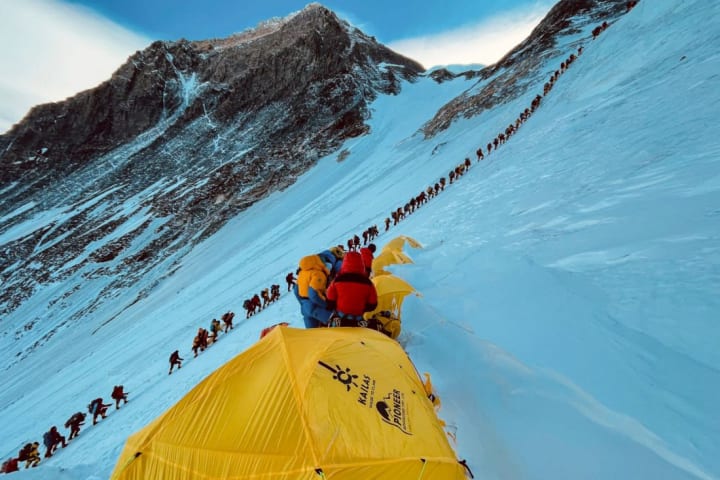People from the East are at the roof of the world
Tenjen Lama Sherpa - one of the most famous mountain guides of his generation. Currently, he and his two older brothers have passed away, and the youngest brother is still climbing mountains to make a living.

Sherpa - more than a profession
In July 2023, Sherpa Tenjen Lama Sherpa guided a Norwegian climber to conquer the world's 14 highest peaks in record time. In a sport that requires extreme determination and faith, Lama has done everything his clients can do, and even more.
But money, fame and attention are not for people like Lama. The economically beneficial certificates given to foreign athletes are not given to the Sherpa people of Nepal. In Tibetan, shar means East; pa is a suffix meaning "person", hence the name Sharpa or Sherpa. For Sherpas, a career as a mountain guide in the Himalayas offers a path out of poverty but also a path that leads to sudden death.
Lama couldn't rest after guiding the Norwegian climber. Life in Kathmandu, the capital of Nepal, is expensive. Lama did not know how to read or write but wanted his sons to have the best educational conditions and that wish was very expensive.
So, just three months after climbing 14 peaks, Lama returned to being a Sherpa - part of his name, his people, his profession and ultimately his destiny. This time, another foreign climber, Gina Marie Rzucidlo, was pursuing a record of becoming the first American woman to climb the world's highest mountains, hiring him as a guide. But on October 7 of that year, an avalanche occurred on Shishapangma peak. Lama and the customer were both killed.
Lama's death is the latest in a series of tragedies in his family. In 2021, Norbu Sherpa - the eldest of the family's four brothers - committed suicide because of love affairs. Last May, Phurba Sherpa - the second oldest person - died while participating in a rescue mission on Mount Everest.
The last surviving brother, Pasdawa Sherpa, received news of Mr. Lama's death when he had just returned from an expedition to the 7th and 8th highest mountains in the world. Over the course of three days, Pasdawa traveled by foot, bus and plane to Lama's apartment in Kathmandu. He knelt down in front of his brother's Buddha altar, eight candles flickering above. Marigolds and a cloth cover a photo of Lama wearing an orange hiking suit and smiling.
Pasdawa closed his eyes and prayed for his dead brothers, and for himself. The youngest brother would have to pursue the only career he had known in life. “I will continue climbing. I have no other choice,” Pasdawa said.

Sherpa's Burden
This is the task that Sherpas often do: Carrying heavy bags and oxygen tanks for customers. Sherpas cook and set up camp. Sherpas move through snowstorms and clean up trash. They woke up before dawn and spent hours hammering metal stakes into the ice so the rope could protect foreign climbers.
Compared to customers, Sherpas spend more time in the so-called dead zone: Altitudes above 8,000m - where human cognition slows without supplemental oxygen and altitude sickness can quickly lead to death .
Walung, the village in northeastern Nepal where Lama and his brothers grew up, is home to about 100 guides who have explored the roof of the world over the past few decades. Locals said that of those 100 people, 15 died while working. The high death rate highlights the inequities of a life-or-death sport. About a third of the more than 335 people who have died on Everest were Sherpas.
The profession offers them high wages by local standards but only a fraction of what most of their clients pay for expeditions.
Nepal's mountaineering industry is a vital source of revenue for the impoverished country, catering to people willing to spend up to $100,000 to climb a Himalayan peak. Almost all customers are foreigners. Every foreign climber, whether beginner or expert, depends on at least one Sherpa, often multiple Sherpas.
During last year’s spring climbing season on Mount Everest, the Nepalese government issued permits to 478 foreigners, the most ever. Eighteen people, including six Sherpas, died on the mountain, another sad record. So far this spring, six people are confirmed dead on the climb and three are missing.
Aside from their disparate income, Sherpas are often relegated to footnotes in climbing history, according to the New York Times. In the global recognition of those who first conquered Mount Everest in 1953, Edmund Hillary ranked first, Sherpa Tenzing Norgay ranked second. The only exception is the airport near Everest Base Camp which is named Tenzing-Hillary Airport.
Rising out of poverty
Whenever possible, after his expeditions - climbing the world's highest peaks 37 times by the time of his death - Lama returned home to Walung, an isolated village in northeastern Nepal. Walung is located in a high valley, below there are fields of barley and millet, where shaggy yaks are grazing, hunched over to fight the cold. Lama and his brothers grew up herding cattle. They play soccer with balls stuffed with cloth.
At that time, the professional Sherpas were mostly from another region in northeastern Nepal. But in the early 2000s, Mingma Sherpa - from Walung - became the first South Asian to conquer the world's 14 highest mountains. Mingma and his three brothers founded Seven Summit Treks, which currently organizes about 1/3 of all Everest expeditions. Mr. Mingma hires most of the guides from Walung.
Lama's eldest brother was already too old when the climbing fever started in the village. But the remaining four brothers joined Seven Summit Treks, turning the company into a true Walung fraternity. Lama got into mountain climbing about a decade ago. Makalu Lakpa - an experienced guide from Walung, Lama's close friend - said: "We eat the same food, drink the same tea, but those brothers are very healthy. Among them, Lama is the strongest person."
In 2019, Lama and his three brothers were recorded in the Guinness World Records when climbing Kangchenjunga, the third highest mountain in the world. Breaking records, as Lama did, means being able to make more money. Climbing an average peak earns a Sherpa nearly $4,000; 8,000m high mountain peaks can earn about 7,500 USD. Sherpa Lama, for climbing 14 peaks, earns about $9,700 per climb, one of the highest fees a Sherpa can command. However, in reality, this remuneration is still much lower than what a top foreign climber can earn and Sherpa's job is potentially more dangerous.
Even as the Walungs have risen to the top of the mountaineering scene, the overall number of Sherpas in Nepal has dwindled, the New York Times points out. Some of the most successful have moved abroad. And few Sherpas want their children to take over. Before his death, Lama also told friends that he hoped his sons, now 16 and 14, would stay away from climbing.
Lama sent his children to study in a good school in Kathmandu. In April this year, Lama's eldest son, Lakpa Sange Sherpa, started a computer studies course. He said he had no interest in climbing mountains. He also no longer speaks much Sherpa - the language his parents, who were born at the foot of Makalu, the world's fifth highest mountain - still speak.
About the Creator
HK Decor
Telling stories my heart needs to tell <3 life is a journey, not a competition
If you like what you read, feel free to leave a tip,I would love some feedback
https://sites.google.com/view/hk-decor/trang-ch%E1%BB%A7
Enjoyed the story? Support the Creator.
Subscribe for free to receive all their stories in your feed. You could also pledge your support or give them a one-off tip, letting them know you appreciate their work.






Comments
There are no comments for this story
Be the first to respond and start the conversation.